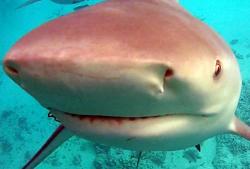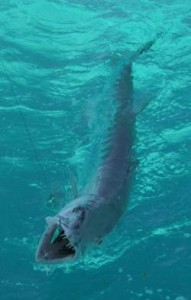Shark Sanctuaries
Rusty Hudson
from The Fishing Wire

Shark
(Editor’s Note: Here’s an interesting assessment of the flurry of shark attacks along the Atlantic Coast this summer, from a retired waterman with decades of experience not only as a harvester of sharks, but also as a consulting expert on the shark fishery for many federal panels. It’s heavy going, with a lot of acronyms, but those interested in really understanding the shark issue may find it instructive.)
The Unintended Consequence from Underfishing and Overregulation
I am Rusty Hudson, a shark specialist with personal experience in United States Atlantic shark fishing since the 1960’s and with Florida watermen heritage dating back several generations along the southeastern US coast. I provide, below, a historical time line and description of factors associated with shark fishery management policy that corresponds with evidence how U.S. shark attacks have increased.
US Shark Attack Graph: http://www.sharkattackdata.com/country-overview/united_states_of_america
During the late 1970’s, the US federal government began a preliminary shark fishery management plan (FMP) by the US Department of Commerce (DOC), the National Oceanic and Atmospheric Administration (NOAA) through the agency called the National Marine Fisheries Service (NMFS) that promoted and encouraged fishermen to land under-utilized marine species (e.g. sharks) for food.
The US commercial fishing industry followed the US government’s advice during the 1980’s to catch, land sharks and develop seafood marketing, domestically and internationally. The public demand for sharks increased in the US at this stage, but the NMFS failed to monitor the commercial coastal shark landings averaging up to fifteen million pounds dressed weight (dw) in the US exclusive economic zone (EEZ).
In the later part of the 1980’s, China, during Deng Xiaoping’s reformation period, increased demand for shark fin soup, one of eight traditional Chinese culinary treasures, as a result of increases in the newly affluent population. Shark’s fin values, and shark harvests worldwide, began to increase significantly into the 1990’s, due to increasing publicity.
Shark Fin Article: http://www.slate.com/articles/health_and_science/green_room/2011/06/sharkonomics.html
By the end of the 1980’s, the NMFS staff began an effort to develop an Atlantic Shark FMP involving the US EEZ area from Maine to Texas, and a portion of the Caribbean Sea region, including the US Territories of Puerto Rico, St. Croix and the US Virgin Islands. On April 26, 1993, the Atlantic Shark FMP final rule was published and the NMFS Highly Migratory Species (HMS) Management Division closed US Atlantic shark fishing on May 15, 1993.
During the early 1990’s, some scientists lobbied the state of Florida to consider a mercury warning resulting from the consumption of shark meat. Overnight, the sale of shark meat fell dramatically throughout the US (a result similar to the media-driven mercury scare over swordfish consumption during the 1970’s). After much mass media hype, the state of Florida and other states mainly established mercury advisories to pregnant women, yet the damage to US fish markets was significant as shark sales fell by more than half. Subsequently, the Atlantic Shark FMP became effective and resulted in additional reductions with coastal shark landings.
Shark fishing began to be negatively publicized in the news media, on television with quasi-science documentaries, and with anti-shark fishing media campaigns, sponsored by environmental non-governmental organizations seeking membership funding.
The Atlantic Shark FMP, in addition to restrictive coastal states shark fishing rules, has been creating what amount to US shark sanctuaries for decades. This has been a result of reliance upon questionable stock assessment results, long rebuilding plans, reduced quotas, lowering trip limits, prohibited shark species, limited access permits, choke species, minimum sizes and closed access for fishing regions.
Below is a timeline of major events that have significantly increased US Atlantic Large Coastal Sharks (LCS) populations near beaches, leading to more shark attacks in my opinion, and negatively interacting with numerous nearshore and offshore fisheries over the past decade in the US Atlantic and Gulf of Mexico regions:
1. In March, 1992, Florida limits commercial shark fishing in state waters to one large shark landed daily, and banned most shark fishing gear, except for rod and reels out to three-miles on the east coast and nine-miles on the Florida west coast. Subsequently, New Smyrna Beach, Florida became known as the “shark attack capital of the world” because of the shark sanctuary benefit from underfishing and overregulation. This area is just south of Ponce de Leon Inlet, and the attacks are mostly by blacktip sharks.
2. On April 26, 1993, the NMFS published the Atlantic Shark FMP final rule with a LCS quota of about 5.3 million pounds (dressed weight) closing Large Coastal Shark (LCS) fishing for 6 months that year [which has reoccurred almost every year], and the NMFS made shark finning illegal. Over two-thousand open access commercial shark permits were bought by fishermen, as required by the NMFS Atlantic Shark FMP new rules.
3. In January 1994 a commercial LCS trip limit of 4000-pounds (dw) was implemented to slow the harvest down; but the fishing season for large coastal species still only lasted about six months that year, and for many shark fishing seasons afterwards.
4. During April 1997 a 50% LCS commercial quota reduction final rule was published, and the NMFS stated that the reduction would not have a negative socio-economic impact. However, under federal court remand, the NMFS later restated that the quota reduction would have “a significant economic effect” on commercial shark fisheries and the ancillary businesses that depended on the LCS resource, which was reduced to nearly 2.6 million pounds (dw) annually.
5. A prohibited shark species complex was started in 1997, and expanded in 1999, but was not founded upon science-based stock assessments for these 19-shark species. Subsequently only one species, the dusky shark, has had a US stock assessment since, conducted during 2006, again in 2010, and an update assessment is scheduled for 2016.
6. During 1999, a limited access permit system was implemented that significantly reduced the US directed shark fishing fleet from Maine to Texas. The number of these limited permits originally issued has shrunk significantly, as they have required annual renewal over the last 15 years. A vessel owner has to purchase an existing shark limited access permit, either a directed or an incidental permit, to sell a shark for food.
7. Closure of areas to pelagic longline (PLL) fishing began during late 2000 into 2001, regulations that currently remain in place for the US Atlantic and Gulf of Mexico PLL fleets. A significant reduction of vessels with the swordfish/tuna fleet occurred in Florida, and elsewhere. The marketing of incidentally-caught sharks fell, helping to cause the pelagic and coastal shark stock populations to expand faster than expected.
8. For the 2003 shark fishing season, based on a new LCS stock assessment, the NMFS raised the LCS quotas up to almost 3.8 million pounds dw, nearly an additional million pounds.
9. Subsequently, in 2004, the NMFS lowered the LCS quota to about 2.2 million pounds dw, until shark dealers could be species specific with the shark identification when submitting landing reports to the NMFS. Since 2007, shark dealers must attend the NMFS special classes to renew their shark identification certificates every three-years.
10. Effective January 01-July 31, 2005 a habitat area of particular concern (HAPC), for the sandbar shark nursery and pupping area, was implemented offshore of North Carolina offshore to 55-fathoms of depth. This action helped enhance the shark sanctuary effect for juvenile sandbar sharks that are preyed upon by other adult shark species (e.g. bull sharks), which feed near the beaches, based on optimal environmental conditions, such as water temperature, that may attract and aggregate prey item forage fish.
11. The controversial 2006 LCS stock assessment by NMFS led to the lower 2008 sandbar shark quota and trip-limit changes for LCS fishing. Sandbar shark was limited to a small shark research fleet with 100% observer coverage, while a 33 non-sandbar LCS trip limit was implemented for the directed shark fishing fleet. This created a virtual day-boat fishery for LCS where landings became less than half as much by weight per trip when compared to the 4000-pound dw trip limit. The historical landings for sandbar sharks were about 38% of the total LCS catch, normally caught offshore, and other commercially important LCS, such as blacktip, bull, lemon and tiger sharks during many conditions are found in or near state waters, rather than just offshore in the US EEZ waters. Shark fins were required to be naturally attached to the dressed carcass until unloaded at the dock with this new NMFS HMS management regulation.
12. Beginning in 2013, the trip limit increased to 36 LCS to land quotas that total about 1.77 million pounds dw, though total LCS landings were 1.42 million pounds dw. The shark sanctuary regions continued to grow because the NMFS used some shark species (i.e. blacknose shark & large hammerhead sharks) as “choke species” to close down larger shark quotas before they were 100% harvested. This unintended consequence from underfishing has created in the US waters a rapid LCS and small coastal shark (SCS) population expansion.
13. The 2014 quotas was set at nearly 1.79 million pounds dw, though total LCS landings were only 1.33 million pounds dw. The 2015 LCS quotas totaled nearly 1.92 million pounds dw though final LCS landings from Maine to Texas will not be known to the public until 2016.
14. Commercial directed shark fishermen have reported, and US government independent shark surveys have documented for several years now, the extremely high catch per unit of effort (CPUE) that is occurring near shore and offshore. (Editor’s Note: A high CPUE means that those who participate in the fishery catch a lot of fish in a short period of time, which usually indicates an abundance of the target species, at least in the targeted area.)
NOAA Coastal Shark Survey 2012: http://www.nefsc.noaa.gov/press_release/2013/SciSpot/SS1309/2012survey.pdf
The NMFS Southeast Fisheries Science Center (SEFSC) claims they do not have enough funding, or NMFS analysts, to conduct shark stock assessments and have significantly delayed future science stock assessments for many shark species as a result. The tentative SEFSC schedule for reassessing sandbar shark has been delayed until 2020. Meanwhile, landings for sandbar shark, dusky shark and LCS species, in general, are setting new CPUE records that must be utilized in future stock assessments to indicate just how far ahead of schedule the rebuilding plans have come in 22 years of management.
15. Non-sandbar LCS fishing opened for the US east coast on July 01, 2015, though the North Carolina HAPC region out to 55 fathoms (330-feet) of depth will not open for shark fishing until August 1, 2015 as required, demonstrating how commercial fishing was not really part of the recent increase of NC shark attacks.
In my professional opinion, the decades of underfishing sharks has led to the unintended consequence of creating shark sanctuaries.
The American public are hearing about more frequent shark sightings and attacks along numerous US beaches. The expanding shark populations are negatively interacting with many US saltwater fisheries, causing large financial losses. These growing shark populations are the unfortunate evidence of how the US federal shark fishery has been poorly managed. The NMFS SEFSC inability to perform timely shark stock assessments is an unacceptable management decision that is negatively affecting the public and shark fishing interests who support sustainable LCS & SCS fishing removals from properly assessed coastal shark stocks.
Russell Howard Hudson is president of Directed Sustainable Fisheries, a commercial fishing support group in Daytona Beach, Florida. He is a retired recreational/commercial fishing captain, and has been deeply involved in coastal fisheries management as a volunteer consultant on a wide variety of federal research panels, particularly those involving shark management.






